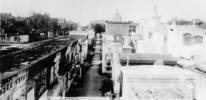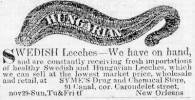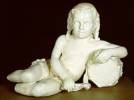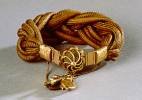 | Find Louisiana State Museum on Facebook |
 | Find Louisiana State Museum on Twitter |
| 2016 Sunset Report |
| OLG & DCRT Strategic Plan 2020-21 through 2024-25 |

- Quality - Louisiana State Library
85% of the users of the State Library indicated that the State Library's services and resources was a good value for the State.Source: The Impact of the Louisiana Department of Culture, Recreation and Tourism on Louisiana's Economy and Quality of Life for Louisiana's Citizens - June 2006
- Louisiana's deep water ports
Did you know that Louisiana's five deep water ports handle more than 457 million tons of U.S. waterborne commerce a year? - Quality - Louisiana State Library
85% of the users of the State Library indicated that the State Library's services and resources was a good value for the State.Source: The Impact of the Louisiana Department of Culture, Recreation and Tourism on Louisiana's Economy and Quality of Life for Louisiana's Citizens - June 2006
- Atchafalaya Heritage Area
The Atchafalaya Heritage Area has been designated by Congress as a National Heritage Area.
- Impact - DCRT Returns Investment Dollars to Louisiana
For every state tax dollar spent by the Department of Culture, Recreation and Tourism, $5.86 is returned to the State Treasury and citizens of Louisiana.Source: The Impact of the Louisiana Department of Culture, Recreation and Tourism on Louisiana's Economy and Quality of Life for Louisiana's Citizens - June 2006
- Impact - Louisiana Office of Tourism Tops Returns on Investment
$13.90 is the return on investment for every dollar spent by the Office of Tourism. Over 175,000 people were directly employed by the Louisiana travel and tourism industry in 2004. In terms of production, $5.9 billion (3.8%) of Louisiana's Gross State Product was directly attributable to expenditures by visitors to LouisianaSource: The Impact of the Louisiana Department of Culture, Recreation and Tourism on Louisiana's Economy and Quality of Life for Louisiana's Citizens - June 2006
- Impact - Supporting the Louisiana Arts
Every dollar in state support for the Arts leverages $7 in earned and contributed revenue. Louisiana's cultural enterprises provide nearly 144,000 jobs for Louisiana citizens, accounting for 7.6% of total employment. Arts has a total economic impact of $934 million in Louisiana.Source: The Impact of the Louisiana Department of Culture, Recreation and Tourism on Louisiana's Economy and Quality of Life for Louisiana's Citizens - June 2006
- Impact - Visitors Generate State Revenue
In terms of tax revenues, visitor spending accounted for $677 million of 2004 Louisiana revenues, or 8.3% of the total 2004 State Budget.Source: The Impact of the Louisiana Department of Culture, Recreation and Tourism on Louisiana's Economy and Quality of Life for Louisiana's Citizens - June 2006
- Quality - Louisiana State Museums
95% of State Museum's visitors strongly agreed or agreed that the State Museum was an educational experience and has expanded their awareness of Louisiana's cultural history.Source: The Impact of the Louisiana Department of Culture, Recreation and Tourism on Louisiana's Economy and Quality of Life for Louisiana's Citizens - June 2006
- Quality - Historic Preservation and the Arts
78-80% of Louisiana residents believe that historic preservation and arts are important and should be high priorities.Source: The Impact of the Louisiana Department of Culture, Recreation and Tourism on Louisiana's Economy and Quality of Life for Louisiana's Citizens - June 2006
- Impact - Louisiana Serve Program
The Louisiana Serve Program in the Office of Lieutenant Governor returns 2.8 million in non-state revenue to Louisiana. - Impact - Louisiana State Museum
The Office of State Museum returns $6.99 for every tax dollar spent.Source: The Impact of the Louisiana Department of Culture, Recreation and Tourism on Louisiana's Economy and Quality of Life for Louisiana's Citizens - June 2006
- Impact - Louisiana State Parks
Visitor spending at Louisiana State Parks returns $3.23 in state taxes for every dollar spend on operating and maintaining all our beautiful parks. Out-of-state visitors to Louisiana State Parks spent almost $12 million in Louisiana and produced an economic impact of over $24 million. Louisiana residents spent another $29.2 million while visiting the parks.Source: The Impact of the Louisiana Department of Culture, Recreation and Tourism on Louisiana's Economy and Quality of Life for Louisiana's Citizens - June 2006
- Impact - Scenic Byways Program
The Scenic Byways program leverages $1.56 for every dollar spent by the program.Source: The Impact of the Louisiana Department of Culture, Recreation and Tourism on Louisiana's Economy and Quality of Life for Louisiana's Citizens - June 2006
- Louisiana State Parks and the National Register
Thirteen Louisiana State Parks sites are on the National Register of Historic Places. They include:
• Audubon State Historic Site
• Centenary State Historic Site
• Fort Pike State Historic Site
• Fort Jesup State Historic Site
• Longfellow-Evangeline State Historic Site
• Mansfield State Historic Site
• Marksville State Historic Site
• Plaquemine Lock State Historic Site
• Port Hudson State Historic Site
• Poverty Point State Historic Site
• Otis House at Fairview-Riverside State Park
• Rosedown Plantation State Historic Site
• Winter Quarters State Historic Site - Louisiana State Parks Visitation
Nearly two million people visited a Louisiana State Park last year. - Louisiana State Parks Grow and Renew
The Louisiana Office of State Parks has spent nearly $80 million in major construction projects since 2004, providing two brand-new parks and a new historic site, adding cabins and campsites to existing parks and building visitor center at one park, the preservation area and three historic sites. - Louisiana State Parks Wireless Internet
The Louisiana Office of State Parks provides free wireless internet access at all 20 recreational parks. Extensive coverage areas include most cabins, RV slips and campsites. - Louisiana State Parks Online Reservations
You can now make online reservations for cabins, campsites, lodges and group camps – at www.ReserveLaStateParks.com - Louisiana State Parks Honors National Parks Service Senior Pass Program
Visitors who hold an America the Beautiful Senior or Access Pass, and whose home State Park system honor the America the Beautiful passes for camping discounts, are entitled to a 50% reduction on camping fees at Louisiana State Parks. Certain restrictions apply, see State Parks' fees & facilities page for more information. - Louisiana State Parks Draw Media Attention
Louisiana State Parks sites have been featured in movie and television releases including "True Detective," CBS’ "Zoo," and "NCIS: New Orleans," "G.I. Joe: Retaliation," "Selfless," "Devil’s Due," and commercials for Popeyes and Toyota. - Capitol Park Welcome Center
The main meeting room in the Capitol Park Welcome Center is named after Margaret Taylor, wife of U.S. President Zachary Taylor. The couple resided in a small house near the present day location of Capitol Park until Taylor was elected to the Presidency.
| Introduction | Native Americans | Colonial Louisiana | The Louisiana Purchase | Territory to Statehood | Battle of New Orleans |
| Antebellum Louisiana I | Antebellum Louisiana II | Antebellum Louisiana III | The Civil War | Reconstruction I | Reconstruction II |
The most deadly diseases to strike Louisiana during the antebellum period were cholera, smallpox, malaria, and yellow fever. In an epidemic year the mortality rate could reach as high as sixty percent of those who contracted a disease. The death rate in New Orleans ranged from a low of 36 per 1,000 in the late 1820s to a high of 1 in 15 during the summer of 1853. Over 12,000 people died of yellow fever in New Orleans that year, with still more deaths in rural areas in south Louisiana, marking the single highest annual death rate of any state during the entire nineteenth century. Because people died faster than graves could be dug, the popular saying was that pretty soon people would have to dig their own graves.
| Casket Lid Almond D. Fisk 1853 The use of cast iron for coffins allowed a wide variety of shapes. Gift of Leonard Huber |
Death rates were highest in urban areas like New Orleans, where large numbers of people packed into small areas spread disease quickly. The filth that accumulated in New Orleans and the swampy areas that surrounded it attracted disease-carrying insects and polluted the water supply. Thousands of sailors and steamboat workers also introduced diseases as they passed through the port.
Yellow fever continued to plague Louisiana until 1905, the year of the last major epidemic. Before scientists at the turn of the century discovered that mosquitoes carried yellow fever, other serious epidemics affected Shreveport in 1873 and New Orleans in 1878.
Primary victims of disease were immigrants, children, laborers, and the poor. Wealthy residents could escape the plague by leaving the city during the most dangerous months, June to November, or afford good health care and clean surroundings.
Many native Louisianians who had been exposed to mild attacks during childhood were immune to yellow fever, malaria, and cholera and were accustomed to their frequent visitations. One such native even praised yellow fever for checking "the tide of immigration which, otherwise, would have speedily rolled its waves over the old population, and swept away all those landmarks in legislation, customs, language and social habits to which they were fondly attached."
Attempts to Control Death
Businessmen and politicians who wanted goods and people to keep coming to Louisiana ignored or purposefully covered up the problem of disease and death. To maintain a wide-open port free of quarantines, business interests tried to convince newspapers and directories not to publish negative news or publicize the astounding number of deaths in New Orleans.
Whig and Know-Nothing politicians who controlled New Orleans during much of the period were reluctant to spend money on preventing or stopping the spread of pestilence. After all, they reasoned, most of the people dying from yellow fever and cholera were Irish, German, and French immigrants who usually voted Democrat.
Because people in the nineteenth century were not aware of what caused many diseases, their cures ranged from the ridiculous to the accidentally logical. Halfhearted efforts, such as poisoning stray dogs and discharging smoke bombs to supposedly kill harmful disease-causing vapors, were tried occasionally. All efforts were unsuccessful until the 1860s, when there was a push to provide the city with more efficient garbage disposal and cleaner markets and slaugherhouses.
Established in 1855, the Louisiana State Board of Health was the first state board in the United States. New Orleans had created its own board of health four decades earlier, in 1817. In an effort to reduce skyrocketing death rates, the Louisiana State Board of Health implemented and oversaw measures relating to quarantine and public health.
Doctors and state officials tried to improve the quality of medical care and their understanding of diseases. After the 1830s Louisiana was the only southern state to require medical licenses for physicians. In response to the 1817 yellow fever epidemic French speaking physicians in New Orleans formed their first professional organization, La Société Médicale de la Nouvelle-Orléans, and English-speaking physicians created the Physico-Medical Society in 1820. Members of both groups devoted their talents and resources to study the recurring pestilence of yellow fever.
Some doctors and pharmacists saw an epidemic as an opportunity to turn a profit. People desperate for relief during the 1853 yellow fever epidemic lodged complaints that pharmacists were charging unreasonably high prices for medicines. In addition, doctors and druggists allegedly conspired to prescribe expensive and unnecessary cures and then shared the profits. Coffin and ice dealers also engaged in price gouging.
Burial and Mourning Customs
Lower Louisiana is famous for its "Cities of the Dead," the cemeteries of above-ground tombs and wall crypts, or "ovens." Because so much of the area is below sea level, coffins did not readily stay in the ground but rather floated to the top. It only took a heavy rain to raise the dead. To address the problem antebellum authorities at times prohibited interment in the ground. Thus, most south Louisianians were, and still are, buried above the earth's surface.
 | St. Louis Cemetery No. 2 George François Mugnier c. 1895 This view shows the arrangement of tombs and wall crypts, or "ovens." |
Burial construction varied by class and faith. Wealthy Louisianians commissioned large, elaborate family tombs, while those with lesser means were buried in small units of ovenlike wall crypts. The very poor who could not afford tombs or crypts were buried below ground, often in unmarked or mass graves. During epidemics the dead were often buried one on top of another.
Jews also interred their dead below ground. According to Jewish belief, the body had to return to the soil and thus was usually buried in the ground in a wooden casket without nails
Antebellum Louisianians mourned the dead by staging elaborate funerals and processions, decorating graves at the time of death and on All Saints' Day and All Souls' Day, placing black wreaths on doors and black ribbons on door pulls, and wearing clothes and jewelry that symbolized stages of mourning. Many customs incorporated Latin and African elements, a cultural heritage from Louisiana's colonial era.
African-American influences on Louisiana mourning traditions included the celebration of funerals with dancing, music, and singing. The wearing of white at funerals and other celebrations involving the dead had religious symbolism and was most likely an African-American cultural carryover. In 1819 English-born architect Benjamin Henry Latrobe encountered a funeral procession in New Orleans for an old Congo slave woman and wrote:
- In going home to my lodgings this evening about sunset, I encountered a crowd of at least 200 negroes, men and women, who were following a corpse to the cemetery. Of the women, one half at least carried candles, & as the evening began to be dark, the effect was very striking, for all the women & many of the men were dressed in pure white. The funerals are so numerous here, or rather occupy so much of every afternoon in consequence of their being, almost all of them, performed by the same set of priests, proceeding from the same parish Church [St. Louis Cathedral], that they excite hardly any attention.
In antebellum Louisiana, and even now, celebration of death did not end with the funeral. On or near tombs and crypts friends and relatives placed immortelles, wreaths commonly made of such durable materials as glass and wire.
According to Latin Catholic tradition, the living also remembered the dead on All Saints' Day (1 November) and All Souls' Day (2 November). They cleaned burial sites, adorned them with flowers and ornaments, and held feasts. Louisianians continue to observe All Saints' and All Souls' Day in much the same way today.





